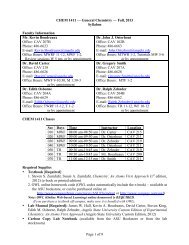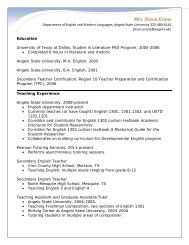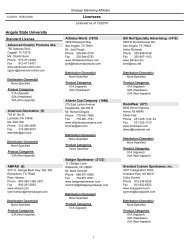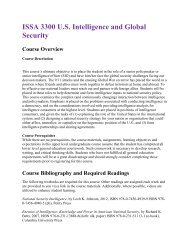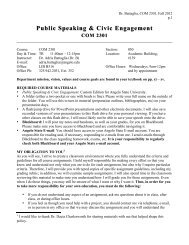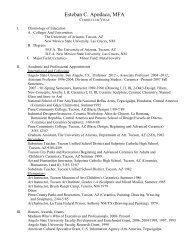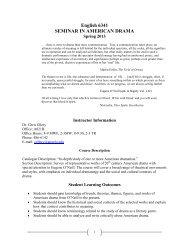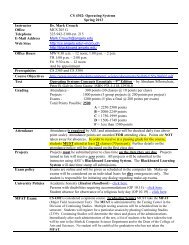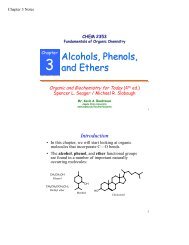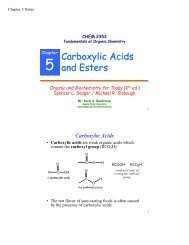Download - Angelo State University
Download - Angelo State University
Download - Angelo State University
Create successful ePaper yourself
Turn your PDF publications into a flip-book with our unique Google optimized e-Paper software.
Chapter 11 Nucleic Acids and Protein Synthesis<br />
Kinds of RNA — Ribosomal RNA (rRNA)<br />
• Ribosomal RNA (rRNA) — the main component<br />
of ribosomes that are the site of protein synthesis.<br />
– rRNA accounts for 80-85% of the total RNA of<br />
the cell.<br />
– rRNA accounts for 65% of a ribosome’s structure<br />
(the remaining 35% is protein).<br />
Kinds of RNA — Transfer RNA (tRNA)<br />
• Transfer RNA (tRNA) — cont.<br />
– tRNA has regions of hydrogen bonding between<br />
complementary base pairs, separated by loops<br />
where there is no hydrogen bonding.<br />
– Two regions of tRNA have important functions:<br />
• the anticodon is a three-base sequence which<br />
allows tRNA to bind to mRNA during protein<br />
synthesis. (It is complementary to one of the<br />
codons in mRNA.)<br />
• the 3′ end of the molecule binds to an amino<br />
acid with an ester bond and transports it to the<br />
site of protein synthesis. An enzyme matches<br />
the tRNA molecule to the correct amino acid,<br />
―activating‖ it for protein synthesis.<br />
The Flow of Genetic<br />
Information<br />
43<br />
45<br />
47<br />
Kinds of RNA — Transfer RNA (tRNA)<br />
• Transfer RNA (tRNA) — delivers individual<br />
amino acids to the site of protein synthesis.<br />
– tRNA is specific to one type of amino acid; cells<br />
contain at least one specific type of tRNA for<br />
each of the 20 common amino acids.<br />
– tRNA is the smallest of the nucleic acids, with<br />
73-93 nucleotides per chain.<br />
Kinds of RNA — Transfer RNA (tRNA)<br />
transfer RNA<br />
activated<br />
tRNA<br />
44<br />
activated<br />
tRNA<br />
(schematic) 46<br />
The Central Dogma of Molecular Biology<br />
• The central dogma of molecular biology states that<br />
genetic information contained in the DNA is<br />
transferred to RNA molecules and then expressed in<br />
the structure of synthesized proteins.<br />
• Genes are segments of DNA that contain the<br />
information needed for the synthesis of proteins.<br />
• Each protein in the body corresponds to a DNA<br />
gene.<br />
48



